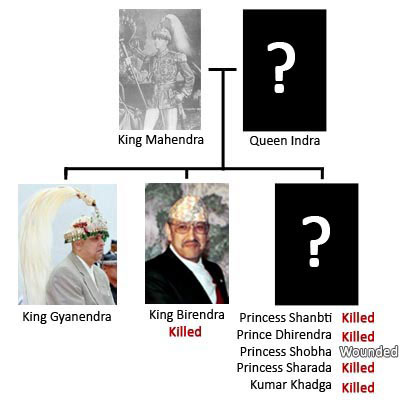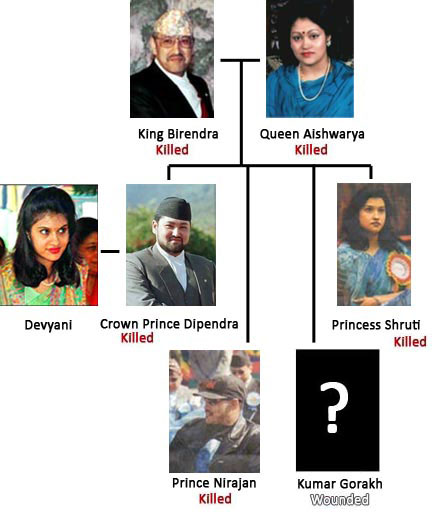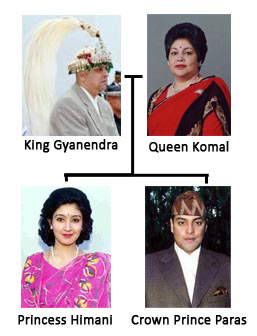A Brief Background of the Events
On June 1st, 2001 in Kathmandu, Nepal, almost the entire royal family was assassinated by the Crown Prince himself. Nine members of the royal family including the King and Queen were massacred by their own son, just before he took his own life. The entire royal family was together on Friday night, and there was an argument between Crown Prince Dipendra (the alleged shooter) and Queen Aishwarya (his mother) over Dipendra’s choice of bride. Dipendra wanted to marry Devyani, but because of her family lineage, her mother did not accept a marriage between the two. It was rumored that King Birendra (Dipendra’s father) threatened to take away Dipendra’s right to heir if he married Devyani. There was certainly some friction between Dipendra and his parents, which may have lead to the massacre that occurred later that night.
The story given by the government of Nepal is that Dipendra became intoxicated, went back to his room, redressed himself into army fatigues, and then came into the billiard room where the rest of the family was. Dipendra was carrying three separate weapons: a submachine gun (MP-5), an M16, and a glock pistol. He ended up shooting nine members of the royal family dead, and injuring four others before shooting himself in the head. Dipendra did not die immediately, but instead he survived two days, was declared King of Nepal while comatose, and then finally passed away. After Dipendra died, his Uncle Gyanendra was declared king. Although the series of events seems fairly straightforward, there are several issues that tend to point towards a cover-up or conspiracy on that fateful night.
Meet the Characters
Below is a family tree of all the characters involved in the massacre on June 1st. Please realize that all the character’s familial associations are not shown, but instead only the pertinent characters to the massacre are displayed. If you are interested in knowing ALL the relations between all the members of the royal family, I suggest looking at Rootsweb.com’s List of Persons. You should also note that the full names of the family members are not shown below.



Dead (not shown): Princess Jayanti (cousin to Birendra)
Wounded (not shown): Ketaki Chester (cousin to Birendra)
Original Thoughts of Conspiracy
Obviously the original conspiracy theory of the massacre stems from the fact that all the direct heirs to the throne were killed…except for the current King Gyanendra. In fact, Gyanendra was conveniently not present in the palace at the time of the massacre…instead he was in the jungle of Chitwan. After examining the family tree images above, one should note that all of Birendra’s brothers and sisters, except for Gyanendra, were targeted for murder that night. In addition, all the family members under Birendra were completely wiped out, except for Devyani (who was not technically married to Dipendra) and Kumar Gorakh, who was targeted by the alleged assassin but not killed. Fortunately for Gyanendra, according to the Nepali constitution, he, as a brother to the King, could only take the throne if there were no sons of the King available to take his position. Dipendra and Nirajan both were killed in the incident, therefore the next heir to the throne automatically went to a brother of Birendra. There were only two brothers of Birendra, and since Dhirendra was assassinated, Gyanendra was the only logical heir to the throne. Kumar Gorakh, who was only injured, was not constitutionally eligible to be King because he was not related to the family through the male side; he was married to Princess Shruti. There is an obvious initial suspicion of a conspiracy because of how “perfect” things worked out for Gyanendra.
Evidence Supporting a Government Cover-up
The most prominent evidence supporting a government cover-up is the fact that the government changed its story of the events. The first story, which was absolutely not accepted by the general public whatsoever, was that an automatic rifle accidentally went off on June 1st, shooting fourteen separate people, killing ten. This is ludicrous and was not a story the Nepali government could get away with.
There is evidence that leads to certain questions being raised. In Dipendra’s glock pistol, there were two bullets fired from that night. Generally, when someone shoots himself in the temple they only really have the ability to shoot the gun once. There were several reports claiming that Dipendra not only drank plenty of alcohol that night, but also smoked a cigarette laced with hashish and an unknown black substance. Paradoxically, the doctor that worked on Dipendra while he was comatose claimed that there was no trace of alcohol or psychotropic substances in his blood with the exception of nicotine. Normally a situation like this could be cleared up by a simple autopsy to determine his actual toxicology screen and if he had two bullets in his body. Instead of investigating the matter, Dipendra was promptly cremated the same day that he was taken off life support and passed away.
The “A Brief Background of the Events” section is essentially a brief summary of a report written by a commission created by King Gyanendra. The report was not made public until King Gyanendra first reviewed the report. There is a conflict of interest between Gyanendra and the commission, which may lead to certain doubts being raised about the credibility of the commission’s report.
A combination of a lack of credibility for the report and certain issues that do not add up lead to further evidence of a conspiracy or a cover-up. Why was Dipendra’s body cremated so quickly after his death? Dipendra’s corpse could have been examined to see if he had fired a weapon the night of the murder based on gunshot residue, or even if he shot himself in the temple or if a third party shot him in the temple. There was no autopsy, and he was quickly cremated so there is no possibility of an autopsy. According to several accounts, Dipendra was seen wobbling and stumbling before and during the massacre because he was drunk. How could Dipendra have been able to shoot so many people so effectively while intoxicated? Why was there no struggle between Dipendra and anyone else in the billiard room? Where were the palace guards? Why was Gyanendra not present that night? There are too many unanswered questions to accept any of the current theories of the events on June 1st.
Maoist Insurgency as a Motive for Murder
An alternative reason for the attack may be a product of the political instability in the region. The Maoist/Communist Party within Nepal has been engaging in what they call the People’s War, which is a pro-democratic, pro-education, pro-women’s rights movement within Nepal. Before 1990 in Nepal, the country was run entirely by monarchy, but in 1990, King Birendra stepped down from ultimate power and instated a democratic-style government, a move opposed by his brother and current king, Gyanendra. Ever since the Maoist movement, Birendra was extremely slow to react against insurgents and was always extremely opposed to any foreign intervention in the matter. Days after Birendra died and Gyanendra took the throne, things began to change extremely quickly. Freedom of speech and freedom of the press were immediately suspended and any journalists that wrote articles hinting at conspiracy were immediately arrested. Communication links were cut for days, public demonstrations were banned, censorship was imposed, and any political leaders in favor of democracy were imprisoned. After Gyanendra took power and began his assault on the Maoist Party, India, Britain, and the United States came to the aid of Nepal with counter-revolutionary tactics. By 2002, Gyanendra completely seized power and dismissed all hints of a democratic government. Gyanendra said that he seized absolute power to save democracy, but the people, and especially the Maoist supporters, are not exactly in agreement with him.
Devyani, the Mystery Character
Obviously one of the closest people to Dipendra was his girlfriend, Devyani. It is even speculated that the couple may have married in secret. According to the commission report, Dipendra called Devyani several times the night of the massacre on his cell phone. In the days following the massacre, Devyani fled the country, and is speculated to have gone to Europe, Moscow, or India. Chances are best she went to India because her immediately family lives in India. She is certainly the best person to find out Dipendra’s mental state before the massacre, but unfortunately she is refusing to return to Nepal.
The Commission Report
For a long synopsis of the commission report on the massacre, please visit Synopsis of the High Level Committee Report on the Royal Palace Incident. Although that website is extremely informative, one must remember that it is written by the bias committee that was appointed and reviewed by King Gyanendra. Although it seems silly to summarize a synopsis of an original document, it is necessary to highlight certain aspects of the official report. Paras, Kumar Gorakh, and Nirajan all took Dipendra back to his room because Dipendra was stumbling after consuming 1-2 pegs of whisky. (Side note: a helpful reader from Nepal has contacted me and told me that a 1 peg is around 100 mL — so 1-2 pegs is about 3-4 ounces, or at the very most, 4 shots of whisky) The cigarette that Dipendra smoked after he got back to his room (a cigarette laced with hashish and a black substance) were nothing new to him; he had smoked the same type of cigarette many times before with no ill effects. Devyani spoke to Dipendra several times on the phone, and actually ended up calling someone else in the palace to check on Dipendra because he sounded dangerously drunk. When someone checked on him, he was found lying on the floor with his shirt unbuttoned and later ended up throwing up into a toilet. How could Dipendra, after being this drunk, have been able to compose himself so well to go back into the billiard room and shoot as many people as he did? Nirajan was issued a glock pistol, but his pistol was never used. Why had Nirajan not fought back? Dipendra fired a total of 47 cartridges from his M16 rifle, 29 from his submachine gun (MP-5), and 2 cartridges from his glock pistol. As stated above, why did he discharge two bullets from his pistol? When people shoot themselves in the head, it just takes one bullet.
Inconsistencies in Website Stories/Why I Wrote This/Disclaimer
One of the main reasons I wrote this was because of a lack of reliable information on the topic of the June 1st massacre in Nepal. There are plenty of websites with information regarding the massacre, but almost none of them agree. They were hastily written just days after the shooting and simply do not have accurate information. I have compiled this website with the most accurate information possible based on all the websites available to me. The fact is, there are plenty of unanswered questions and speculation that make their way to the internet. Please keep in mind that the information on this webpage is not guaranteed to be accurate, especially because there are only a few people that know the actual truth. The best we can do is decide what happened for ourselves based on the information available to us.
Evidence Against a Conspiracy
Obviously I have a strong slant favoring a conspiracy, but there is some evidence that supports that Gyanendra and the government had no part in the murders. The most obvious evidence is the fact that Queen Komal was injured in the shooting. If Gyanendra or Paras were responsible for the shooting, I doubt that they would want to shoot their own wife/mother. In addition, although it is not difficult to “persuade” people to change their eyewitness accounts, it should be noted that all the witnesses at the palace that night finger Dipendra as the shooter. It is also believed that the black substance in the cigarette that Dipendra smoked may have acted as a stimulant, which may explain how he was able to return to the billiard room after vomiting into his toilet and laying on the floor in a drunken stupor.
Conclusion
What actually happened that night? The world may never know, but it is certainly worth examining to decide for yourself. It is interesting that the United States, although it is technically fighting a communist and terrorist-like organization (the Maoist insurgents), it is still supporting an anti-democratic government. Currently Nepal is far from democracy, but we are fighting on their side against the pro-democratic faction in Nepal. Go figure. Without a doubt something is going on, but it’s up to us to decide what actually happened.


